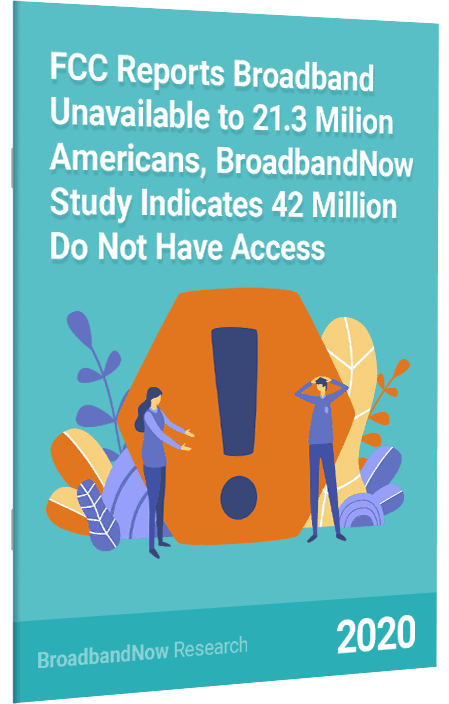BroadbandNow Research manually checked availability of more than 11,000 addresses using Federal Communications Commission (FCC) Form 477 data as the “source of truth.” Based on the results, we estimate that 42 million Americans do not have the ability to purchase broadband internet.
Editor’s Note: A newer version of this report has been released. Click here to view our 2021 FCC over-reporting study.
The FCC’s Broadband Deployment Report states that 21.3 million Americans, or 6.5 percent of the population, lack access to broadband internet, including wired and fixed wireless connections. This figure relies upon semi-annual self-reporting by internet service providers (ISPs) using the FCC-mandated “Form 477.”
However, there is a widely acknowledged flaw with Form 477 reporting: if an ISP offers service to at least one household in a census block, then the FCC counts the entire census block as covered by that provider. BroadbandNow Research examined the magnitude of this flaw by manually checking internet availability by address using FCC data as the source of truth for randomly selected addresses.
Based on our research, we estimate that 42 million Americans do not have access to wired or fixed wireless broadband. Specifically, here’s what we did and how we arrived at this estimate:
- BroadbandNow Research selected nine large ISPs with “check availability” tools. These tools allow users to enter an address and receive a response as to whether wired and/or fixed wireless service is available.
- From there, we selected 11,663 addresses (from a set of more than 1 million) where at least one of these nine large ISPs offer service according to the FCC’s Form 477 data.
- We checked each address/provider combination. We found that for 19.6 percent of combinations, the ISP’s tool indicates service is not available.
- Address locations selected at random and include major internet markets like Dallas and Chicago as well as mid-size cities like Denton and Richmond.
- Some addresses are serviced by more than one of the nine large ISPs according to FCC data. For 13.0 percent of addresses, none of the ISPs’ tools indicate service is available.
- FCC data shows that approximately half of these addresses are also served by one or more local or hyper-local ISPs (the US has more than 2,000 ISPs). We were not able to check availability for local ISPs, and therefore conservatively assumed that residents of these addresses could receive broadband.
- In total, we estimate that 42 million Americans do not have the ability to purchase broadband internet. This is an additional 6.5 percent of Americans beyond FCC estimates.
State-Level Data: FCC Reporting Flaw Hits Rural Communities Harder
Ending the digital divide requires affordable broadband options for rural communities and therefore it is useful to look at false positives at the state level.
Unfortunately, as with many of the issues surrounding the digital divide, FCC overreporting disproportionately impacts rural communities. As an example, in South Carolina, where 50 percent of residents live in an urban area, unserved addresses are 30 percent higher than FCC estimates. Compare that to Arizona, where 90 percent of residents live in an urban area and unserved addresses are 11 percent higher.
Chart: FCC and BroadbandNow Estimates of Broadband Availability, by State
Table: FCC and BroadbandNow Estimates of Unserved Americans, by State
| State | Population (1) | Unserved: FCC 2019 Estimate (2) | Unserved: BroadbandNow 2020 Estimate (3) |
|---|---|---|---|
| United States | 325.71 | 21.31 | 42.82 |
| Alabama | 4.88 | 0.68 | 1.36 |
| Alaska | 0.74 | 0.15 | 0.29 |
| Arizona | 7.02 | 0.92 | 1.84 |
| Arkansas | 3.00 | 0.68 | 1.37 |
| California | 39.54 | 1.17 | 2.35 |
| Colorado | 5.61 | 0.40 | 0.79 |
| Connecticut | 3.59 | 0.03 | 0.06 |
| District of Columbia | 0.69 | 0.01 | 0.03 |
| Delaware | 0.96 | 0.02 | 0.05 |
| Florida | 20.98 | 0.90 | 1.60 |
| Georgia | 10.43 | 0.79 | 1.58 |
| Hawaii | 1.43 | 0.06 | 0.11 |
| Idaho | 1.72 | 0.25 | 0.51 |
| Illinois | 12.80 | 0.68 | 1.37 |
| Indiana | 6.67 | 0.67 | 1.35 |
| Iowa | 3.15 | 0.29 | 0.59 |
| Kansas | 2.91 | 0.26 | 0.52 |
| Kentucky | 4.45 | 0.40 | 0.81 |
| Louisiana | 4.68 | 0.58 | 1.17 |
| Maine | 1.34 | 0.09 | 0.18 |
| Maryland | 6.05 | 0.15 | 0.29 |
| Massachusetts | 6.86 | 0.14 | 0.28 |
| Michigan | 9.96 | 0.79 | 1.59 |
| Minnesota | 5.58 | 0.29 | 0.58 |
| Mississippi | 2.98 | 0.61 | 1.23 |
| Missouri | 6.11 | 0.69 | 1.39 |
| Montana | 1.05 | 0.14 | 0.29 |
| Nebraska | 1.92 | 0.25 | 0.49 |
| Nevada | 3.00 | 0.22 | 0.44 |
| New Hampshire | 1.34 | 0.07 | 0.14 |
| New Jersey | 9.01 | 0.09 | 0.17 |
| New Mexico | 2.09 | 0.35 | 0.70 |
| New York | 19.85 | 0.32 | 0.64 |
| North Carolina | 10.27 | 0.54 | 1.08 |
| North Dakota | 0.76 | 0.05 | 0.10 |
| Ohio | 11.66 | 0.62 | 1.25 |
| Oklahoma | 3.93 | 0.83 | 1.66 |
| Oregon | 4.14 | 0.32 | 0.64 |
| Pennsylvania | 12.81 | 0.61 | 1.22 |
| Rhode Island | 1.06 | 0.02 | 0.04 |
| South Carolina | 5.02 | 0.51 | 1.02 |
| South Dakota | 0.87 | 0.10 | 0.19 |
| Tennessee | 6.72 | 0.59 | 1.18 |
| Texas | 28.30 | 2.07 | 4.17 |
| Utah | 3.10 | 0.18 | 0.36 |
| Vermont | 0.62 | 0.07 | 0.13 |
| Virginia | 8.48 | 0.70 | 1.41 |
| Washington | 7.41 | 0.20 | 0.40 |
| West Virginia | 1.82 | 0.28 | 0.56 |
| Wisconsin | 5.80 | 0.50 | 1.01 |
| Wyoming | 0.58 | 0.11 | 0.22 |
(1) Population (millions) from FCC 2019 Broadband Deployment Report
(2) Population (millions) unserved by "terrestrial" broadband internet from FCC 2019 Broadband Deployment Report.
(3) Population (millions) unserved by "terrestrial" broadband internet according to BroadbandNow Research 2020 Study.
* for these states, data was not statistically significant
Underreporting Impacts both Homes and Apartments
Our study found 22 percent of provider/address combinations for houses and 19 percent of provider/address combinations for apartments did not have service available. A large reason for the discrepancy is that apartments happen to over-index in urban rather than rural parts of the country. Urban areas, due to dense populations, tend to have census blocks that are narrow in square miles, whereas rural areas, with less population density have wider and less concentrated blocks. This increases the probability of those blocks having overstated coverage, because while one house could reach a wired line, the next house (which could be acres away) might not. Despite this, under the current system, it will still be counted. In addition, urban areas have historically had the most buildout of wired lines and longer established coverage.
Curious about internet access in the U.S.?
- See how all 50 states rank for internet access, pricing, and speeds. (Hint: New Jersey is the best, Alaska is the worst.)
- Check out in depth statistics for every city in the county, including internet access in Dallas, Los Angeles, and Detroit.
- You can search for internet service providers in your area here.
Where Do We Go From Here?
The key question for policymakers is how to get better data. The FCC announced it is changing its data collection from Form 477 to geospatial broadband coverage maps and citizen crowdsourcing.
BroadbandNow Research believes that provider reporting on address-level availability is the best and most transparent way to understand and quantify the digital divide. We also believe that FCC reporting should be more timely (FCC Form 477 data is typically made public 12-18 months after ISPs self-report).
Address-level availability would have additional benefits such as increasing competition, which we have shown to reduce prices for consumers.
About This Study
BroadbandNow Research manually checked provider availability at nine ISP web sites that offer online “check availability” tools. We checked at least one provider for 11,663 addresses from a dataset of more than 1 million addresses. In total, there were 20,065 provider-address combinations checked, of which a sample was re-checked for errors. We also verified the existence of a sample of addresses using real-estate sites. Based on the results of the study, we estimate a 19.6 percent error rate for provider-address combinations across the U.S. For addresses with multiple providers checked, 13 percent of the time none of the providers offered service. Many small and mid-sized providers do not offer online “check availability” tools and so could not be checked manually. Approximately half of the addresses in our sample did not have a local ISP alternative (according to FCC Form 477). When we assume that only addresses without local alternatives are unserved, the total unserved population in the US is 42 million (compared to the FCC’s reported 21.3 million), making this a conservative estimate (unserved population may be higher).


